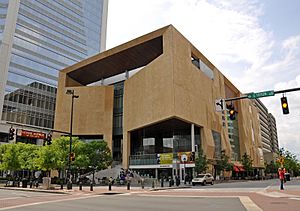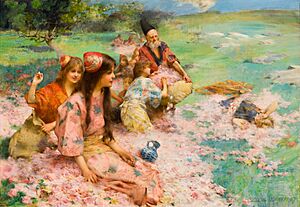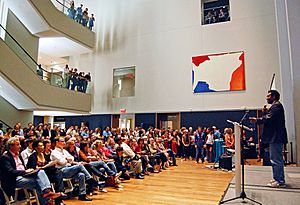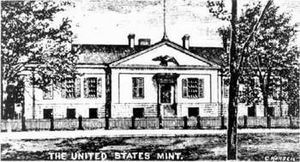Mint Museum facts for kids
The Mint Museum is a cool place in Charlotte, North Carolina. It's actually two museums in one! The Mint Museum Randolph and Mint Museum Uptown show off amazing art and designs from all over the world.
In 2018, Dr. Todd A. Herman became the new leader of The Mint Museum. Before him, Bruce LaRowe was the temporary leader starting in 2017.
Contents
Mint Museum Randolph: A Historic Art Spot
| Established | 1936 |
|---|---|
| Location | 2730 Randolph Road Charlotte, North Carolina 28207 |
| Type | Art |
The Mint Museum Randolph is in a special old building. This building used to be the Charlotte Mint, where money was made! It opened as an art museum in 1936. This made it the very first art museum in North Carolina, USA.
The museum has many different collections. These include American Art, old art from the Americas, and art made from ceramics. You can also see decorative art, North Carolina Pottery, and historic clothes. There's also African Art, Asian Art, old maps, Contemporary art, and photography.
Amazing Art Collections at Randolph
The Mint Museum is the biggest art place in Charlotte. It has the largest public collection of art by Romare Bearden. He was a famous artist born in Charlotte.
The American Art collection has about 900 artworks. These pieces were made between the late 1700s and around 1945. You can see portraits, landscapes, and paintings by a group called "The Eight". Famous artists like John Singleton Copley and Gilbert Stuart also have art here.
The Art of the Ancient Americas collection is huge! It has about 2,000 objects from over 40 different cultures. These items are more than 4,500 years old. You can see jewelry, tools, pottery, sculptures, and metal art.
The Contemporary Art collection has about 2,230 objects. This includes the Romare Bearden collection. It also features modern sculptures and photos made from 1945 until today.
The Mint's Decorative Arts collection is one of the best in the country. It has over 12,000 objects, mostly ceramics. These range from ancient Chinese pottery to European dishes from the 1700s. The museum has the biggest collection of North Carolina pottery in the whole nation. Some pieces are from the 1700s!
The Delhom collection was given to the Mint in 1966. It has 2,000 pieces of old pottery and porcelain. Some of these are pre-Columbian pieces, which are over 4,500 years old.
The museum also has a collection of Historic Costume and Fashionable Dress. It includes almost 10,000 items of clothing for men, women, and children. These range from the early 1700s to modern high fashion. It shows how fashion is an art form.
Mint Museum of Craft + Design: Celebrating Creativity
| Established | 1999 |
|---|---|
| Location | 500 South Tryon Street Charlotte, North Carolina |
| Type | Craft and Design |
The Mint Museum of Craft + Design celebrates the rich history of craft in the Charlotte area. It collects artistic crafts made from glass, metal, fiber, wood, and clay. This includes jewelry and furniture.
With over 2,500 artworks, its collections show how craft has changed over time. They go from useful objects in the 1800s to modern art today. This museum is known as one of the top craft museums in the country.
It first opened in 1999. A large donation helped the Mint Museum of Art buy a separate space for its craft and design collection. The collection is described as "complex and eclectic." It features everything from fine jewelry to fiber art and even funny ceramic sculptures.
The museum moved in February 2010 to its new home. It reopened as part of the Mint Museum Uptown in October 2010. This move made the gallery space much bigger, from 10,000 square feet to 18,000 square feet.
Mint Museum Uptown: A Modern Art Hub

The Mint Museum's new, large location opened on October 1, 2010. It was built with help from grants and the Arts & Science Council. This building is known as the Mint Museum Uptown. It cost about $57 million to build.
The Uptown location has five floors. It holds collections of glass, ceramics, wood, and other materials from the Mint Museum of Craft + Design. Also, Contemporary Art, American Art, and some European Art collections moved here from the Randolph Road building. This means that for the first time, the Mint's craft, fine arts, and design are all under one roof!
The historic Randolph Road building is still open. It has been updated to show off the museum's collections of Ceramics, Historic Costume and Fashionable Dress, Ancient American Art, Asian Art, Coins & Currency, Decorative Arts, and Spanish Colonial Art.
The Historic Randolph Road Building
The oldest part of the Randolph Road building has a cool history. It was once the first branch of the United States Mint. This means it was a place where gold coins were made! The building was designed by a famous architect named William Strickland. Construction started in 1836. It opened on July 27, 1837, at its first location. From 1836 until the Civil War, it made $5 million in gold coins.
In 1931, the building was in danger. The county wanted to expand the main post office next to it. People wanted to save the building, but it seemed impossible. Then, in 1933, a group of citizens raised money to move the building. They took it apart and moved it to its current spot on Randolph Road. The museum officially opened to the public on October 22, 1936. It was North Carolina's first art museum. The building was made bigger in 1967 and 1985.
The building was named a Historic Landmark in 1976. In April 2012, the museum announced plans for a research center there. This center focuses on North Carolina pottery. It lets scholars and students study the museum's large pottery collection and archives. The pottery archives have 19,000 books and documents.
Mint Museum of History: A Separate Story
The Mint Museum of History started in 1976 at the Hezekiah Alexander House. The Mint Museum managed this site until 1987. Then, the city's parks and recreation department took over. At that time, its name changed to the Charlotte Museum of History.




